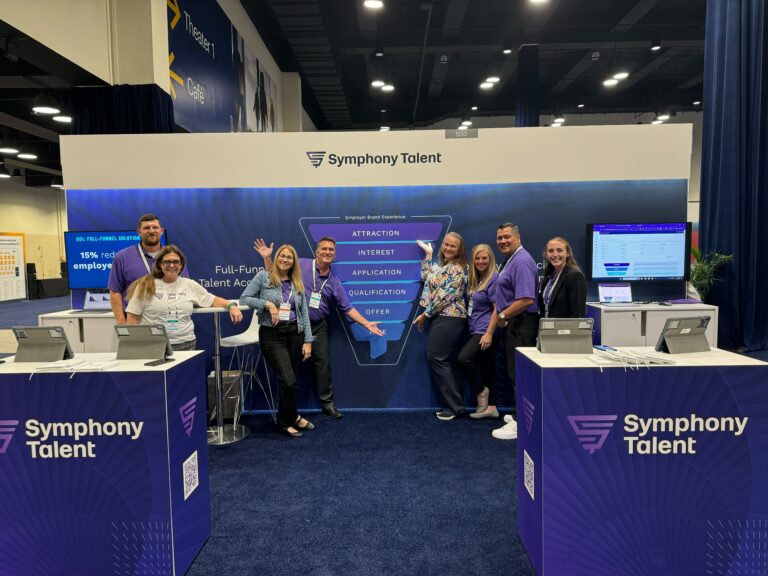At the 2024 Gartner ReimagineHR Conference, thousands of HR professionals, vendors, analysts, and industry leaders gathered to discuss the future of HR. Talent acquisition professionals shared actionable insights to help HR leaders and their teams redefine recruitment success. From smarter decision-making strategies to redefining recruitment ROI through full-funnel analytics, the conference offered forward-looking perspectives on the rapidly evolving HR landscape.
Our team joined forces with with Hilton Grand Vacations and ADT in sessions exploring the impact of data-driven recruitment and integrated solutions. These discussions showcased how our suite of full-funnel solutions, expert brand services, and comprehensive data analytics can create exceptional candidate experiences and drive measurable outcomes across the entire talent acquisition funnel.
Beyond sharing our clients’ successes, we were there to learn. Gartner’s team of industry analysts presented statistics and trends in talent acquisition, revealing the latest insights to help HR leaders bridge gaps, leverage technology, and prepare for the opportunities and challenges ahead in 2025.
Key stats shaping HR's future
The Gartner sessions were packed with compelling data to guide HR’s focus in 2024:
- 72% of recruiting leaders say HR needs to be more agile than pre-pandemic.
- 45% of recruiting leaders report heightened pressure to improve hire quality, underscoring the importance of reliable metrics.
- 75% of HR leaders say they don’t do a good job communicating EVP internally to their employees
- 25% of workers will need updated skills, a jump from 8% in 2020, with GenAI driving much of this demand.
- AI saves employees an average of 5 hours weekly, yet 41% of this time saving is lost to redundant tasks. Strategic alignment of AI with meaningful work is crucial.
Three top TA trends heading into 2025
Optimizing recruiter roles with AI
AI featured prominently throughout the entire Gartner conference. One of the most compelling use cases was the definition of tailored applications for different recruiting roles:
- High-volume recruiters: Virtual assistants and automation reduce manual tasks, allowing more time for sourcing.
- Corporate recruiters: AI assists with candidate matching, freeing recruiters to focus on candidate and manager engagement.
- Niche recruiters: AI supports market insights and targeted prospect engagement.
Takeaway: The role of the recruiter and how they can benefit from AI is not one size fits all. If the organization invests in aligning recruiters with role categories (segmentation) and the right technology, their efforts can be more streamlined and cost-effective.
Revamping EVP for attraction and retention
Employer value propositions (EVPs) have evolved beyond a one-time initiative into a dynamic strategy to retain and engage talent. This trend will continue into 2025 with robust EVPs that resonate with internal and external talent and push new hires and retention.
- Investment: 65% of HR leaders have increased their EVP investments, yet 75% find internal EVP communication challenging.
- Action steps: To strengthen an EVP, HR should embed it across the employee lifecycle, empower managers to communicate it, and act on feedback for continuous improvement.
Takeaway: As EVPs drive talent retention and engagement, organizations must adopt a proactive, lifecycle-focused approach that empowers teams and prioritizes ongoing communication to resonate with current and future talent.
Dealing with pressure to deliver more with less
To keep teams focused and spending their time appropriately, progressive organizations are taking a segmented approach to hiring.
- Categories: Organizations must first evaluate and categorize their job requisitions based on factors such as the role's level of urgency, complexity, and impact on organizational goals.
- Structured support: By defining these categories, organizations can align their service models accordingly, dedicating appropriate resources and effort to each requisition type. This structured approach reduces the chance of recruitment bottlenecks and ensures that each job opening is given the right level of attention and resources tailored to its specific requirements.
Takeaway: Segmenting job requisitions is a powerful way to optimize talent acquisition processes. It enables organizations to allocate their teams’ time and resources more effectively, ensuring that high-priority positions are filled promptly while maintaining consistent quality across all hires.
Learn how to tackle these trends head-on with SFX Insights
From AI and EVP to segmenting requisitions, these discussions highlighted actionable strategies for TA leaders and practitioners to overcome modern challenges. For those ready to embrace the new wave of talent acquisition, Gartner ReimagineHR underscored the need to harness advanced insights, rethink the EVP, and create a streamlined hiring process.
Symphony Talent’s commitment to this mission remains stronger than ever as we continue to develop cutting-edge solutions like SFX Insights, designed to optimize recruitment practices throughout every candidate touchpoint and every stage of the funnel.
Explore how SFX Insights can power your talent acquisition strategy.




